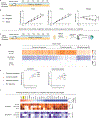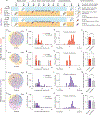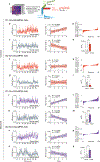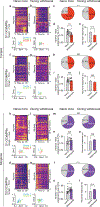Drugs of abuse hijack a mesolimbic pathway that processes homeostatic need
- PMID: 38669575
- PMCID: PMC11077477
- DOI: 10.1126/science.adk6742
Drugs of abuse hijack a mesolimbic pathway that processes homeostatic need
Abstract
Drugs of abuse are thought to promote addiction in part by "hijacking" brain reward systems, but the underlying mechanisms remain undefined. Using whole-brain FOS mapping and in vivo single-neuron calcium imaging, we found that drugs of abuse augment dopaminoceptive ensemble activity in the nucleus accumbens (NAc) and disorganize overlapping ensemble responses to natural rewards in a cell type-specific manner. Combining FOS-Seq, CRISPR-perturbation, and single-nucleus RNA sequencing, we identified Rheb as a molecular substrate that regulates cell type-specific signal transduction in NAc while enabling drugs to suppress natural reward consumption. Mapping NAc-projecting regions activated by drugs of abuse revealed input-specific effects on natural reward consumption. These findings characterize the dynamic, molecular and circuit basis of a common reward pathway, wherein drugs of abuse interfere with the fulfillment of innate needs.
Conflict of interest statement
Competing interests:
The authors declare that they have no competing interests.
Figures





Update of
-
Drugs of abuse hijack a mesolimbic pathway that processes homeostatic need.bioRxiv [Preprint]. 2023 Sep 5:2023.09.03.556059. doi: 10.1101/2023.09.03.556059. bioRxiv. 2023. Update in: Science. 2024 Apr 19;384(6693):eadk6742. doi: 10.1126/science.adk6742. PMID: 37732251 Free PMC article. Updated. Preprint.
Comment in
-
Reprioritizing motivations in addiction.Science. 2024 Apr 19;384(6693):271. doi: 10.1126/science.ado9989. Epub 2024 Apr 18. Science. 2024. PMID: 38669580
References
-
- Hyman SE, Malenka RC, Nestler EJ, Neural mechanisms of addiction: the role of reward-related learning and memory. Annu Rev Neurosci 29, 565–598 (2006). - PubMed
-
- Koob GF, Le Moal M, Drug addiction, dysregulation of reward, and allostasis. Neuropsychopharmacology 24, 97–129 (2001). - PubMed
-
- Kalivas PW, Volkow ND, The neural basis of addiction: a pathology of motivation and choice. Am J Psychiatry 162, 1403–1413 (2005). - PubMed
-
- Ahmed SH, Koob GF, Transition from moderate to excessive drug intake: change in hedonic set point. Science 282, 298–300 (1998). - PubMed
Publication types
MeSH terms
Substances
Grants and funding
LinkOut - more resources
Full Text Sources
Molecular Biology Databases

